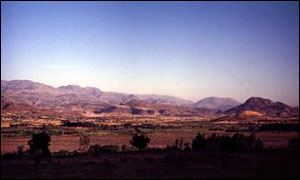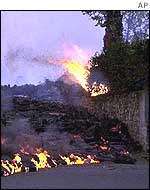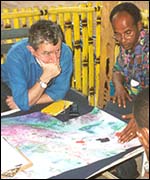

"The Ethiopian rift is one of the few places in the world where we can see the transition from continental rifting to something that looks more oceanic," Dr Cindy Ebinger told the BBC World Service's Discovery programme. "It's a unique area worldwide."
The crack in the Earth's surface runs for 2,000 kilometres from Malawi in the South, through Tanzania, Kenya and Ethiopia, to link-up with the Red Sea and the Gulf of Aden.
A look deep into the Earth's interior shows a huge plume of warm soft mantle rock rising diagonally from the core's boundary and running up beneath Southern Africa towards the Afar region of Ethiopia.
Volcano valley
The mantle super-plume, as it is called, may be responsible for the high elevation of much of Southern and Eastern Africa.
It may also account for the line of volcanoes that runs up the Great Rift Valley, including Mount Nyiragongo, which recently sent red-hot lava pouring into the Congolese eastern town of Goma.

More
than half of Goma was been consumed by lava
|
By the time it joins up with the Red Sea it is more like a mid-ocean ridge, a line of cracks along which volcanic magma rises to create the floor of an ever widening sea.
In Ethiopia it is in transition between the two and this gives geologists their best chance of studying how a new ocean forms.
Earth tremors
Project Eagle (Ethiopian Afar Geophysical Lithospheric Experiment) draws together researchers from Royal Holloway College London, and the universities of Leicester, Leeds and Addis Ababa.
The project aims to see deep into the Earth by using many sensitive seismometers to record natural earth tremors and the vibrations from explosive charges detonated in boreholes.

Project
EAGLE researchers map out the terrain
|
In this way, Dr Cindy Ebinger and her colleagues hope to discover any reservoirs of hot, molten magma within the crust that could feed future volcanoes as well as seeing how the crust is thinned as it is pulled apart.
"There are several dormant volcanoes but there has never been a study to monitor volcanoes in the rift," Dr Ebinger explained.
"These are dangerous because the lava has more silica in it and is resistant to flow, so these are explosive eruptions that can cause death and damage to a large region."
New ocean
So far, the indications are that a mantle plume alone is not enough to open an ocean.
There needs to be a sideways pull to rift the continent, allowing the hot magma to rise underneath to fill the gap and form the floor of the new ocean.
Opinions vary over whether that will actually happen along the East African rift.
With the Atlantic Ocean still opening and pushing on Africa from the west and India still colliding with Asia and the Indian Ocean opening to the east, there may be nowhere for the rift to expand.
Further north however, the picture may be different, said Professor Peter Maguire, of Leicester University.
"We do believe that we are on the transition from continental to oceanic rifting," he explained.
"The continent in the northern part of Ethiopia is separating and there will be an ocean penetrating down into East Africa."